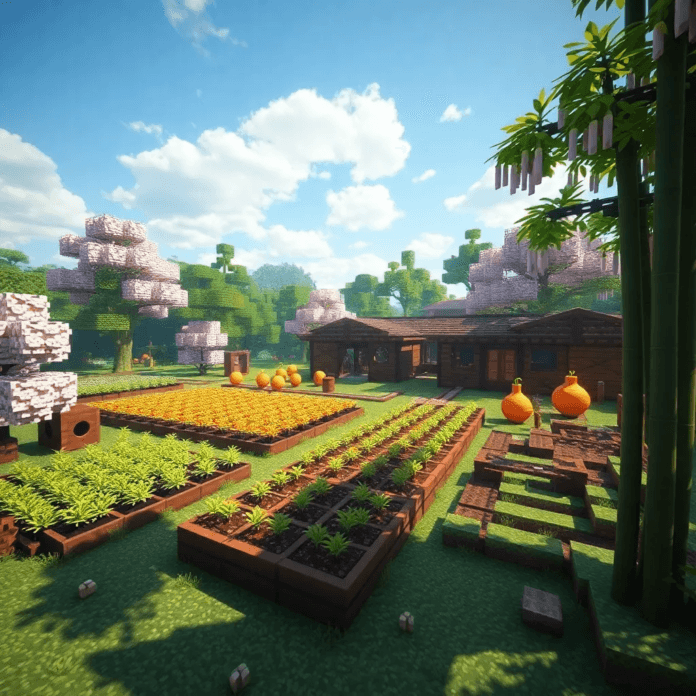Automatic farming in Minecraft 1.20: New options and optimizations
The release of Minecraft 1.20 has opened up exciting new possibilities for players to construct and optimize automated farms. This update version brings fresh mechanics and blocks that take the farming experience to a new level. Let's take an in-depth look at the innovative farming methods that are now available.
The sniffer: A new mob for intelligent farming systems
One of the most exciting new features is the introduction of the sniffer. This adorable mob can be used to create a whole new kind of farm. The Sniffer has the unique ability to detect and dig up buried seeds. Used cleverly, this can lead to an efficient automatic seed farm.
Advantages of the sniffer in farms:
- Automated seed search: sniffers automatically search large areas for hidden seeds.
- Increased efficiency: Reduces manual effort when collecting rare resources.
- Continuous production: By using several sniffers, a constant supply of seeds can be guaranteed.
Imagine you have a demarcated area where snoopers roam freely and continuously dig up rare seeds for you. With an ingenious system of hoppers and conveyor belts, these seeds could be transported directly to your storage boxes. This automates and optimizes the entire seed procurement process.
The pitcher plant: a versatile addition to automatic farms
The introduction of the pitcher plant also opens up new farming perspectives. This two-tiered plant grows from pitcher capsules that can be dug up occasionally by the sniffer. An automated pitcher plant farm could look like this:
1st seed search: sniffers dig out the pitcher capsules.
2. automatic planting: The excavated cans are automatically planted on arable land.
3. harvesting process: After full growth, the plant is harvested by a mechanism controlled by observers and cobs.
The result would be a steady production of this fascinating new plant, which can be used not only decoratively but also functionally.
Torchflower: Innovative combination with chicken farms
The torchflower, another novelty in 1.20, also offers interesting possibilities for automatic farms. Its seeds can be eaten by chickens, which could lead to a combined torchflower and chicken farm.
Possible farm structures:
- Keeping chickens: Chickens are kept in a separate area.
- Seed collection: Hopper funnels under the hens collect laid eggs and surplus seed.
- Automatic reseeding: The collected seeds are automatically resown to create a continuous cycle.
This combination not only ensures an efficient production chain, but also an aesthetically pleasing farm design.
Calibrated Sculk sensors: Precise automation with Redstone
The introduction of calibrated Sculk sensors opens up completely new possibilities for farm automation. These redstone components can filter vibrations based on their frequency, allowing for more precise control over your farm automation.
Application examples:
- Selective animal processing: With a calibrated sculk sensor, you can only recognize certain mob noises and thus selectively sort or process animals in your farm.
- Optimized resource management: Sensors can be used to react specifically to certain events, such as harvesting plants or collecting resources.
- Redstone mechanisms: The precise control enables complex redstone circuits that make farm management more efficient.
This leads to more sophisticated yet user-friendly farming systems that consume less energy while generating more output.
Aesthetic improvements: Decorations and bamboo for more beautiful farms
The new ornamental patterns for pots that can be found through archaeology do not offer any direct farming benefits, but could be used to aesthetically enhance your farms. Imagine an automated flower farm where the harvested flowers are presented in ornately decorated pots - a combination of efficiency and beauty.
Bamboo as a building material:
The introduction of bamboo as a fully-fledged wood set opens up new possibilities for the construction of farm structures. Bamboo grows quickly and can now be processed into different types of blocks. This allows for the construction of aesthetically pleasing yet functional farm buildings. Imagine a multi-story automated farm built entirely from bamboo materials that blends seamlessly into a jungle or Asian-inspired building style.
Design ideas:
- Themed farms: Use bamboo for farms that fit a specific biome or theme.
- Decorative elements: Integrates ornate pots and bamboo elements to make the farm visually appealing.
- Sustainable look: Bamboo gives farms a natural and sustainable aesthetic that fits well into the Minecraft world.
Creative use of banners and mob heads
The ability to place banners on shields may not seem directly related to farming at first glance. However, creative players could use this to mark different areas of their automated farms or even create a visual guidance system for complex farm systems.
The new mob heads, especially the Piglin head, can also be used in conjunction with note blocks to create ambient sounds. This could be used for sophisticated mob farms where certain sounds attract or deter mobs.
Practical applications:
- Area marking: Different banner colors and patterns can mark different parts of the farm.
- Noise control: Mob heads with note blocks can improve the atmosphere and increase the efficiency of mob farms.
- Visual communication: Signs and banners can serve as visual cues for controlling complex farm processes.
Improved structures: desert temples and ocean ruins
The improvements to existing structures such as desert temples and ocean ruins could indirectly affect automated farming. The introduction of suspicious sand and gravel in these structures means that automated farms could now also produce archaeological finds. Imagine an automated sand mining facility that not only yields sand, but occasionally valuable artifacts as well.
Possible extensions:
- Archaeological farms: Integration of extraction systems that specifically collect sand and gravel from structures.
- Resource diversity: Increasing the available resources through the extraction of archaeological finds.
- Additional content: Use found artifacts for construction and decoration projects within the farms.
New mounts and teamwork on large farms
The introduction of the camel as a new mount may seem to have little to do with farming at first glance. But its ability to carry two players could be useful for maintaining and monitoring large automated farm systems. Imagine riding a camel with a friend through your sprawling farm landscape and planning improvements together.
Teamwork and efficiency:
- Joint exploration: Use the camels to inspect larger farm areas more quickly.
- Resource management: Two players can take on tasks at the same time to run the farm more efficiently.
- Fast response: Joint approach to troubleshooting or optimizing the farm systems.
This new mobility option encourages collaboration and makes farm management even more dynamic and fun.
Armor decorations and role assignment in multiplayer
The new armor decorations do not offer any direct farming advantages, but could be used to visually identify different roles in a multiplayer farming team. The farm manager wears gold-decorated armor, while the harvesters wear copper decorations - a playful way to bring order to larger farm operations.
Advantages of role assignment:
- Clarity: Clear visual differentiation of team roles.
- Motivation: Players feel more involved in their role through individual embellishments.
- Efficient collaboration: A well-organized team works together faster and more effectively.
The introduction of such visual elements makes teamwork more harmonious and productive.
Archaeology and automated excavation farms
The introduction of the brush tool for archaeology opens up interesting possibilities for semi-automated excavation farms. Although the process of brushing itself is manual, clever redstone mechanisms could be used to automatically transport and position suspect sand or gravel.
Possible systems:
- Automatic sorting: use of funnels and trampling to sort archaeological finds.
- Redstone-controlled processes: Automation of material movement to support the excavation process.
- Increased efficiency: Reduction of manual effort through semi-automatic systems.
This integration of archaeology and automatic mining creates new dimensions in farm management and significantly expands the game's possibilities.
Improved biomes: Cherry Blossoms and Trail Ruins Structures
The improvements to the cherry blossom biome could be used to create aesthetically pleasing automated farms. Imagine an automated bee farm surrounded by flowering cherry trees - a perfect combination of functionality and beauty.
Design ideas:
- Natural integration: use of cherry blossoms for a harmonious farm design.
- Bee production: Setting up an efficient bee farm for honey and wax production.
- Visual appeal: Flowering cherry trees enhance the appearance of the farm and create a relaxing atmosphere.
The new Trail Ruins Structures offer opportunities for automated exploration farms. Although the structures themselves are not directly farmable, automated systems could be developed to search the environment for these structures and collect valuable resources.
Automated exploration:
- Resource collection: Use of Redstone and Redstone functions to automatically search Trail Ruins.
- Increased efficiency: Faster and more comprehensive collection of resources from the ruins.
- Extended possibilities: Integration of the collected resources into existing farm systems.
Conclusion: Minecraft 1.20 revolutionizes automatic farming
To summarize, Minecraft 1.20 offers a wealth of new possibilities for automated farming. From the integration of new mobs like the Sniffer, to the use of new plants like the Pitcher Plant and Torchflower, to the improved redstone capabilities of calibrated Sculk Sensors, the possibilities for creative and efficient farm designs are nearly endless.
The real strength of these innovations lies in their combinability. Experienced players will undoubtedly find ways to combine these different elements into complex and highly efficient farm systems. We may soon see farms that use sniffers to find rare seeds, then automatically plant them in an aesthetically pleasing bamboo structure, while calibrated sculk sensors monitor and control the entire process.
It is important to emphasize that these new farming options are not only interesting for efficiency enthusiasts. For players who value aesthetics and atmosphere, the new features in 1.20 also offer exciting possibilities. From ornately decorated pots to the ambient sounds of mob heads, your farms can now be not only productive, but also beautiful and immersive.
In conclusion, Minecraft 1.20 takes automatic farming to a new level. It offers a perfect balance between new challenges for experienced players and accessible options for newcomers to automated farming. Whether you're aiming for highly efficient resource production or an aesthetically pleasing, atmospheric farm landscape, Minecraft 1.20 gives you the tools to realize your vision. The only limits are your creativity and imagination. So, what are you waiting for? Dive into the world of Minecraft 1.20 and create the automated farm of your dreams!





